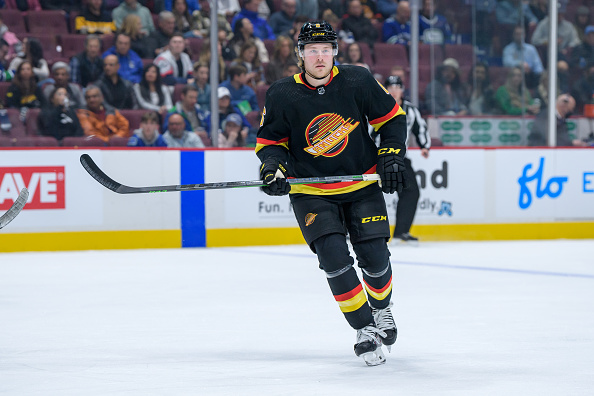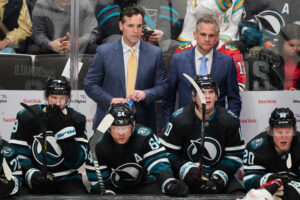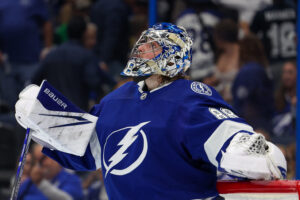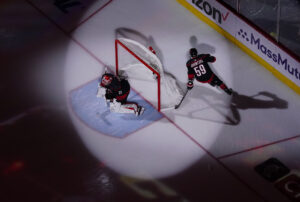Player development seems to always result in more questions than answers. How likely is it for a top pick to pan out? What makes a player a “steal”? Last Word On Hockey has a new series on how to properly develop prospects from all different spots throughout the draft. This week’s piece involves draft picks in the back half of the first round and how they were used early in their careers.
NHL Player Development Of First-Round Picks
In the span of 2005 through 2015, there were 84 total selections made between 16th overall and 30th overall on forwards playing in North America. Looking at all 84 forwards, they were split into different categories. Those categories were “Forwards Deemed NHL-Ready and Brought In Immediately When Ready,” “Forwards Near NHL-Ready and Brought In Immediately When Near-Ready,” “Forwards Rushed Slightly,” “Forwards Rushed,” “Forwards Forced,” “A Little Patience,” “Patience,” and “Too Much Patience.”
There were 12 forwards who fell into the fourth category, “rushed,” on the list. Of those 12 players, seven made their NHL impacts in their DY+3 season. Those players are Michael McCarron, Brock Boeser, Colin White, Tyler Ennis, Chris Stewart, Quinton Howden, and Josh Ho-Sang. In this piece, we look at Michael McCarron and Brock Boeser.
Michael McCarron
McCarron, who was drafted 25th overall in the 2013 NHL draft by the Montreal Canadiens, came out of the US National Team Development Program. In his DY-1 season, playing for the U17 squad, he scored six goals and 21 assists for 27 points in 53 games, for 0.509 points per game. That ranked 64th out of the aforementioned 84 forwards in DY-1 production. He followed that up with 16 goals and 21 assists for 37 points in 59 U18 games, for 0.627 points per game. That ranked 78th out of the same 84 forwards in DY production.
The following two seasons, McCarron would head north to play in the OHL with the London Knights in his DY+1 season. That year, he recorded 14 goals and 20 assists for 34 points in 66 games, for 0.515 points per game. That ranked 76th out of the 82 forwards still outside the NHL in DY+1 production. The following season, his DY+2, he would be traded by the Knights midseason to the Oshawa Generals. Between the two teams, he recorded 68 points in 56 games for 1.214 points per game. That ranked 19th out of the 70 forwards still outside the NHL in DY+2 production. McCarron would see the NHL the following season, joining the Canadiens roster. But his NHL player development wasn’t a fit for the Canadiens.
How McCarron Was Used
In his first professional season, McCarron would split between the AHL and NHL. At the AHL level, he recorded 17 goals and 21 assists for 38 points in 58 games. Meanwhile, in the NHL, he would play just 20 games, while averaging just 11:41 time on ice per game. In that small role, McCarron produced just two points. His analytics were not strong either, though he did show some value in one specific area. His even-strength offence goals above replacement (EVO) were poor, as evidenced by his raw stats, at a -1.1 score. But his even-strength defence goals above replacement (EVD) were above replacement level, solid for a rookie, at 0.1. While the defence was where he brought value, it was not enough to carry his all-situations analytics. His wins above replacement (WAR) and goals above replacement (GAR) were both below replacement level, at -0.5 and -2.6, respectively.
The following season, McCarron would again play between the AHL and NHL. In the AHL, he played 32 games and scored seven goals and 12 assists for 19 points. Then, in the NHL, he would play more games than the year prior, at 31, but average less ice time, at 9:53 per game. Despite the ice time being reduced, he would produce more points than the year prior, with five points. That still is not good production for a first-round pick. His analytics would improve in all categories, however. His EVO (-0.8) was still rough, but better. McCarron’s EVD (0.8) also improved. With the improvement defensively, his WAR (0) and GAR (0.2) would both escape the below replacement level territories.
Third Year, Same Story
In his third season, McCarron’s NHL role would decrease even further. In the AHL, he would play 54 games, scoring seven goals and 17 assists for just 24 points. Meanwhile, he would play fewer NHL games than either of his first two seasons, at 18 games played, and average even less ice time, at 8:46. That resulted in McCarron scoring just one single point. Believe it or not, his even-strength stats were above replacement level despite that poor production. Specifically, his EVO was up at 0.6, a new high. Meanwhile, his EVD dropped to 0.2 but was still better than his rookie year score. But again, his very small role, regression and games played, and poor raw stats painted the picture of his third season. His WAR (-0.1) and GAR (-0.5) were both below replacement level.
How McCarron’s NHL Player Development Turned Out
Following that third season, in 2017-18, he would play two AHL seasons between the Laval Rocket (Montreal) and Milwaukee Admirals (Nashville Predators) scoring 48 points in 88 games. Then, in 2020-21, he would play two seasons at the NHL level, for a combined 57 games, totalling 14 points. He would finish that second season, in 2021-22, in the AHL playing 14 games and scoring six points. This upcoming season, he is slated to play on the Predators NHL squad. Looking back, based on his production pre and post-draft in junior leagues, it’s clear he just was not the right pick. His NHL player development was not a big issue, though it is true he was not given a big or consistent role either. But, looking at the players taken after McCarron, there were better options.
Shea Theodore was taken one pick later. Ryan Hartman and J.T. Compher were two forwards who went within the next 10 selections. Then, a bit further out, were Arturri Lehkonen (who the Canadiens drafted anyways), Tyler Bertuzzi, Jake Guentzel, Pavel Buchnevich, and several other forwards taken within the next two rounds.
Brock Boeser
Boeser, drafted 23rd overall in the 2015 NHL draft by the Vancouver Canucks, came out of the Waterloo Black Hawks organization of the USHL. In his DY-1 season, he played for Burnsville High School in Minnesota. With Burnsville, he scored 21 goals and 25 assists for 46 points in 24 games, for 1.917 points per game. That ranked eighth out of the 84 forwards in DY-1 production, albeit in high school. He joined Waterloo in the following year, scoring 35 goals and 33 assists for 68 points in 57 games played, for 1.193 points per game. That ranked 39th out of the 84 forwards in DY production. Upon getting drafted, Boeser would join the University of North Dakota in the NCAA for two seasons.
In his DY+1 season with North Dakota, he scored 27 goals and 33 assists for 60 points in 42 games, for 1.429 points per game. That ranked 14th out of the 82 forwards still outside the NHL in DY+1 production. Boeser would follow that up with 16 goals and 18 assists for 34 points in 32 games, for 1.063 points per game. That ranked 28th out of 70 forwards still outside the NHL in DY+2 production. Boeser would join the Canucks following his second NCAA season.
How Boeser Was Used
In his first NHL season, Boeser would play 62 games, averaging 17:30 per game. In that large role, he scored 29 goals and 26 assists for 55 points. He would be the runner-up for the Calder Trophy, awarded to the rookie of the year. With that in mind, it’s no surprise he had strong analytics. His EVO (7.7) was extremely impressive. While his EVD (-1.4) was not impressive at all, that’s usually the score for rookies anyways. Also, his defensive impacts did not bring down his game, as his WAR (2.4) and GAR (12.2) were both really strong scores for a rookie forward.
Following that great season, Boeser would play 69 games the next year, averaging 19:10 per game, a big jump up from the year before. He scored 26 goals and 30 assists for 56 points in that new role. Meanwhile, his analytics were… strange. All of his even-strength analytics improved, with his EVO up at 9.5 and his EVD above replacement level, at 0.7. However, his WAR (1.8) and GAR (9.9) both dropped. That occurrence is not common, but the reason behind it is Boeser’s special teams impact dropped. Looking at his goal totals, in his rookie year, he totalled 10 powerplay goals compared to the six he scored in year two. His powerplay point totals also dropped, from 23 to 15.
NHL Player Development: Production Dips, But Impacts Remain Strong
In his third season, Boeser played 57 games, averaging 18:34 per game. In that role, he scored 16 goals and 29 assists for 45 points. That remains his career-low in goals and points to this day. With that step-back in production, it makes sense that his EVO (8.5) dropped a bit from the season prior. However, his EVD (2.2) hit a new high, while his WAR (2.1) and GAR (12) both returned to his rookie season impacts.
Ever since that third season, in 2019-20, he’s remained with the Canucks. In total, he has played 127 games over the last two seasons, scoring 46 goals and 49 assists for 95 points, while averaging 18:55 per game. It’s safe to say that Boeser, especially compared to McCarron, was given a large role that many players drafted in the second half of the first round don’t generally receive. A combination of being lucky that the Canucks had the openings on their roster and his big leaps in personal development in college is the reason for that.
That said, his NHL player development went as well as it could have gone. If Boeser did not deal with injuries throughout his young career, who knows how much more he could’ve done. At least, production-wise, for the Canucks. Boeser has had his name in trade rumours for quite some time now. It’s safe to say that if he were to get dealt, he’d be a solid top-line option when healthy for whatever team gets him.
Junior league stats via Elite Prospects, NHL stats via Hockey Reference, NHL analytics via Evolving Hockey






